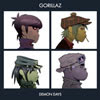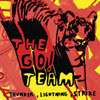
I recently found myself in a most unexpected situation. I stood under a dockside crane, my shoes gripping the concrete quay through pooled blood, posing with four college friends under the scrutiny of half-a-dozen cameras and three massive game wardens. I was sweaty, tired, hungry, plastered with sunblock, and, most of all, elated. To the sound of camera clicks, diesel outboards, and the snapping kill-flag flying off the docked boat’s yardarm I hung my arm over the dorsal fin of a shark almost twice my size and smiled.
I had never participated in the death of any sizable creature before. As a kid I had once taken a pot shot at a squirrel with a bb gun, and, of course I’ve doomed my fair share of insects and arachnids. Despite four prior fishing trips, I had caught neither fish nor crustacean. The closest I’d ever come to a successful hunt was when I witnessed a friend of mine catch crabs in a trap (a scant few crabs, in fact, compared to the cost of the chicken used to lure them).
So when I was recently invited to go deep-sea fishing as part of a college friend’s bachelor weekend in Delaware, I was skeptical that I’d see anything caught except for a hangover.
We set out from the Indian River inlet around six in the morning aboard the
#1 Hooker, the five of us led out to sea by a middle-aged captain and his senior first mate. For six hours we motored and dragged lines through the captain’s favored fishing areas. We passed over and around shipwrecks, undersea hilltops, and deep trenches. But nothing disturbed our lines. Once a line snapped, pulled free of its pins on the portside and we jumped to attention. Kelp was our disappointing prey.
Then, about thirty minutes before it was time to turn back – silent and empty-handed – a line snapped. I was watching the sonar at the time, looking for the infrequent green, yellow, and red reflections of fish beneath the boat. Not a single blip showed for 100 feet down on the small back screen,
But the line had snapped. I feared a repeat of our earlier false alarm – a fear quickly abated. We amateur fishermen jumped out of our torpor as quickly as the line had snapped off the yardarm. The celebrated weekend’s bachelor was pushed into the reelman’s chair while the first mate pulled the fishing rod from its mount, ramming it into the waiting cradle mounted between the bachelor’s thighs.
The captain was immediately relived, suggesting we had finally caught the bluefish we’d come out hunting for. But the line was pulling fast, the bachelor struggling to keep it taut – struggling even more to reel it in, foot by difficult foot. The first mate nodded at the captain and us, smiling through yellow teeth. “It’s no bluefish,” he said. “It’s a thresher.”
The level of excitement on board the small boat flared. We’d hooked a shark. The first mate coached the bachelor, showing him how to reel the fish in as the boat chased it backwards and how to pull the rod before letting it fall, reeling in the meager slack. He reeled and pulled, straining his arms but unwilling to give up the chair. The fishing line we were using was too weak to haul the shark in by brute force, and several times the shark gained the upper hand, overwhelming the tension in the reel and dragging line outward to gain distance.
It was twenty minutes into the fight before the fish showed itself. Its blue and silver iridescent back showed through the crest of a nearby wave, the dorsal fin barley breaking the surface. The captain yelled down from the bridge, warning us the watch of for its tail – the thresher shark’s primary weapon. But in another instant that fear, too, was abated. Our lure, an eight-inch metal fish coated in barbs, was hooked through the shark’s long and dangerous tail.
I’d never seen a shark outside of an aquarium. Nor had I ever been out of sight of land before. The first mate took one look at that shark and sent me below deck to do something else I’d never done. I returned from the bow compartment with the shotgun.
Another fifteen minutes went by before the exhausted shark was brought against the stern boards. Several times we thought we’d lost the fish, as it dove straight down, forcing the bachelor out of his chair and against the stern rails. But now, as the shark rolled onto its back, motionless within arm’s reach of the outboards, the first mate, one of my friends, and I reached out with long barbed gaffs and hooked the fish’s shinning, heavy body.
With three hooks plunged into its flesh, the first mate shot the shark in the head. But twenty minutes later, as we prepared to pull the fish on board, the tail began to move. Another shot from the first mate, this time inside the shark’s mouth, insured us its death. While the victorious bachelor massaged his throbbing arm – tight from the prolonged fight – I helped haul the shark over the side of the boat and onto the deck. The entire process, from capture on the line to tie-down onboard, lasted slightly more than one hour.
For some time, we sat around the long fish, blood slipping out its open mouth and down fiberglass channels into the ocean. Its head was nearly pressed into a corner of the open aft, the tail so long it curled menacingly toward the reelman’s chair that had helped the bachelor defeat it. We toasted the shark, and ourselves, and joked about how exaggerated this tale of amateur maritime adventure would become before we returned to our disparate homes. 10 feet? It would be 20 by the time we met again for the wedding.
We would later discover that the thresher shark we caught that afternoon, 28 miles off Ocean City, Maryland – whom we lovingly named Amy, in honor of the bride-to-be – measured 10’5” from nose to tail and weighed 166.2 pounds. Upon our return to the marina, the cleaning crew was able to recover over 70 pounds of 3/4 inch shark steak and an impressive jaw from its body.
Why do I relate this story through such an open medium? To make a practical point about the value of game hunting and male bonding over bloodshed? To make a metaphysical point about the nature of manhood and the existential quality of the hunt? Hardly. That hot mid-Atlantic afternoon, hunkered down with suntan lotion and Dramamine we were prepared to go home empty handed. We were prepared for a return to the marina with an empty boat – with no flag of victory flying from the yardarm.
Some of us, myself and the bachelor included, had never caught a fish before. None of our ensemble had ever caught one this large, or impressive. It was a first for all of us. The bachelor alone at the reel could never have defeated the shark, nor could the others and I alone have wrestled it into the boat. Whatever the individual task – reeling, gaffing, piloting, shooting, tying, photographing – for an hour on the open sea five friends, who saw each other less and less as the years went by, had acted as one organism. Despite the measures of distance and time that have separated us – despite the clumsy silences and infrequent communications that remind us of this distance – we quickly gelled again and worked together as seamlessly as if we’d never missed a beat in each other’s company.
The bachelor and I joked about never fishing again – with such a fortuitous catch at the outset of our fishing careers, our next catch could only bring disappointment.
We are older. We live in different cities. We have wives and careers and separate groups of friends. But we have shared memories that keep us together – old and new.
Thanks to Amy.
fb
 In his dual roles as a college arts professor and a graphic design professional, Cloudjammer principal J.D. Jordan often finds himself in the unenviable position of competing with his students for work – defending himself against neighborhood kids who market themselves for $35 and a six-pack. This Newsweek editorial takes a personal look at both sides of a problem in artistic education: the lack of creative business preparation in art colleges and the impact it has on working professionals.
In his dual roles as a college arts professor and a graphic design professional, Cloudjammer principal J.D. Jordan often finds himself in the unenviable position of competing with his students for work – defending himself against neighborhood kids who market themselves for $35 and a six-pack. This Newsweek editorial takes a personal look at both sides of a problem in artistic education: the lack of creative business preparation in art colleges and the impact it has on working professionals. Newsweek is a national and international newsweekly with a worldwide circulation of more than 4 million and a total readership of more than 21 million. Newsweek offers comprehensive coverage of world events with a global network of correspondents, reporters and editors covering national and international affairs, business, science and technology, society, and arts and entertainment and features such notable commentators as Allan Sloan, Anna Quindlen, George Will, and Fareed Zakaria. Newsweek holds more prestigious National Magazine Awards, given by the American Society of Magazine Editors, than any other newsweekly. fb
Newsweek is a national and international newsweekly with a worldwide circulation of more than 4 million and a total readership of more than 21 million. Newsweek offers comprehensive coverage of world events with a global network of correspondents, reporters and editors covering national and international affairs, business, science and technology, society, and arts and entertainment and features such notable commentators as Allan Sloan, Anna Quindlen, George Will, and Fareed Zakaria. Newsweek holds more prestigious National Magazine Awards, given by the American Society of Magazine Editors, than any other newsweekly. fb
























